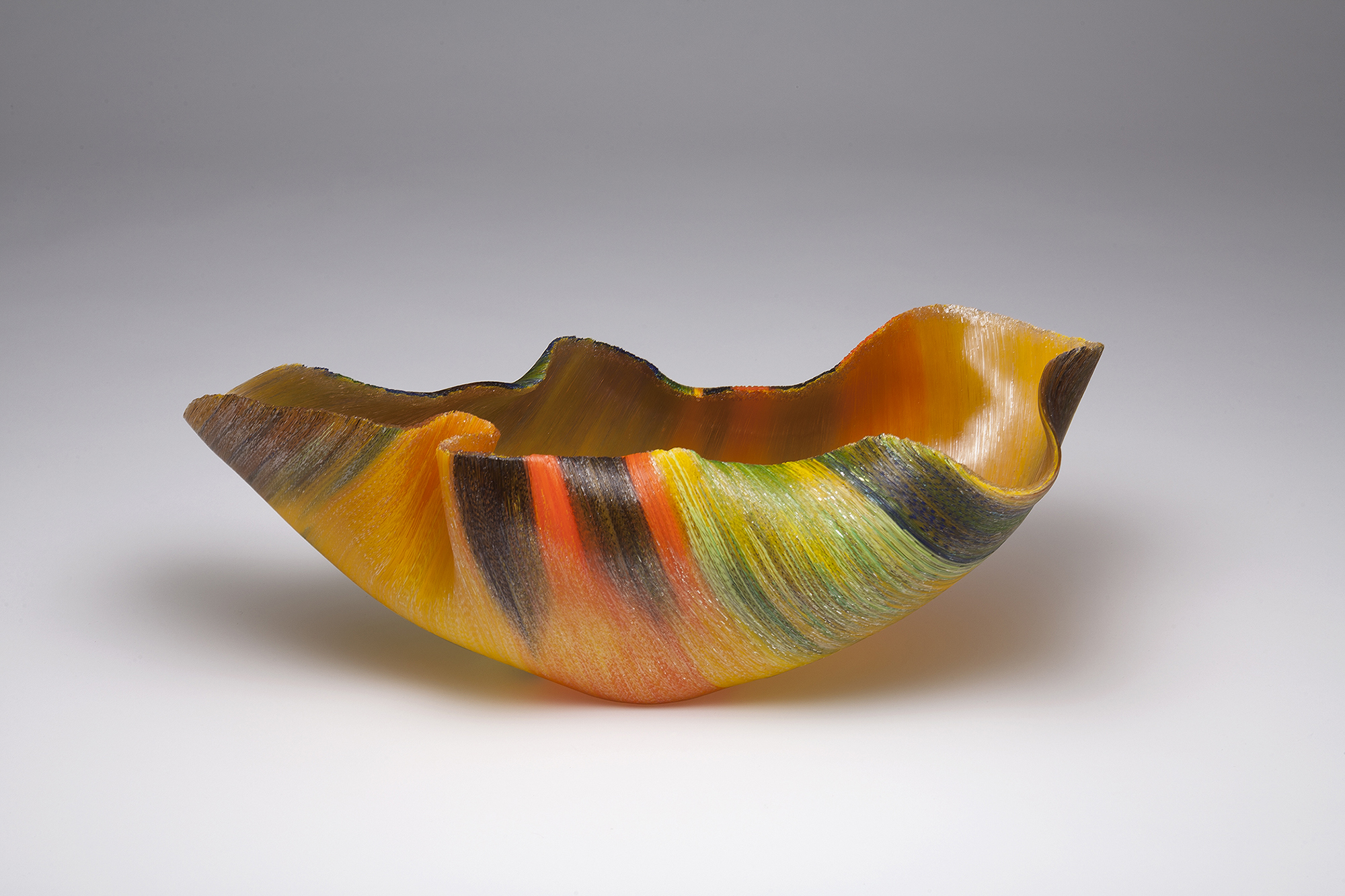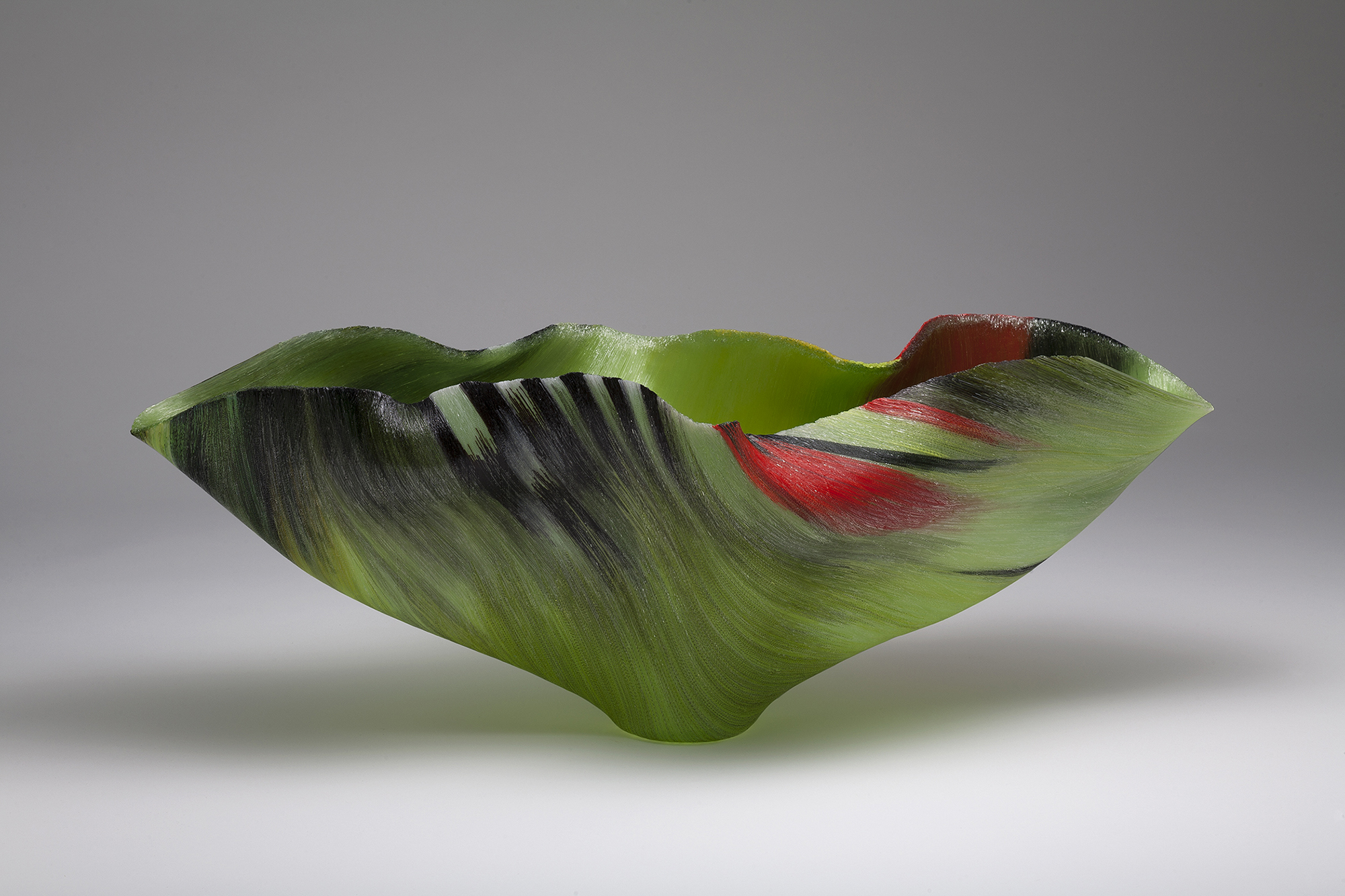Toots Zynsky’s glass Endangered Species series honors at least one bird species from each of the 7 continents: Africa, Antarctica, Asia, Australia/Oceania, Europe, North America and South America.
These species differ in the extent to which their populations or geographic range have already declined. They represent a spectrum.
South America’s Sun Conures are classified as endangered – that is, the best available evidence indicates this species faces a very high risk of becoming extinct in the wild. Africa’s Blue Crane and Hawaii’s (Oceania’s) I’iwi are categorized as vulnerable, indicating a high risk of extinction in the wild. Europe’s Iberian Green Woodpeckers are ranked near threatened, meaning close to being endangered or vulnerable, or likely to become so in the near future.

Toots Zynsky, Baltimore Oriole (2018). Region: North America. Filet de verre (glass thread). Dimensions: 10 3/4″ x 18 3/4″ x 10 1/4.” © Zynsky, 2018. Courtesy of Heller Gallery.
Other species are of less concern for risk of extinction: they are sufficiently numerous, wide-ranging and have not yet lost 30% of their population, avoiding thresholds for vulnerable classification. Yet even these species face serious threats when humans indiscriminately cut down forests and destroy natural habits for poorly planned farming, industrial and development projects. As suitable bird habitats shrink, Asia’s Mandarin Duck and Plum-Headed Parakeet populations appear to be declining. The esteemed Cornell Lab of Ornithology and Maryland Department of Natural Resources report that North America’s Baltimore Orioles are also declining due to habitat loss.
Climate change compounds these hazards, transforming habitats, driving species away and disrupting relationships between predators and prey. Species then face a stark choice: adapt quickly or perish. For example, as Antarctica continues to warm, its King Penguins may have to travel significantly farther to reach their cold-water prey, complicating survival in a harsh and rapidly changing environment.
Zynsky’s glass series highlights the scale of what is happening to birds – and beckons action. The comprehensive 2018 State of the World’s Birds report warns that at least 40% of the world’s bird species already suffer declining populations. And the United States, Canadian and Mexican governments warn in their State of North America’s Birds 2016 report that one-third of North American bird species need urgent conservation action.
Yet when humans take timely action, bird populations can rebound. At least twenty-five bird species have been rescued from the brink of extinction this century; others once endangered are now deemed only vulnerable.
So here are 5 simple things you can do to help:
- Get the facts. Read the 2018 State of the World’s Birds and the State of North America’s Birds 2016 so you can talk knowledgeably about what is happening to birds in your community and worldwide – then share your knowledge with others.
- Let government officials at all levels – federal, state and local – know your concern for the rapid decline in bird populations. Ask for their help in protecting birds.
- Collisions with glass windows kill up to a billion birds a year in the United States alone. Make your home, workplace and school bird-friendly: hang curtains or decals or explore other solutions to deter birds from flying into windows.
- Volunteer with local citizens organizations that survey, count and rescue birds.
- Like Toots Zynsky, use your artistic or visual talents to draw attention to the plight of birds. For an inspiring short film on how one eleven year old student made a difference, see: Olivia’s Birds and the Oil Spill.
This summary of the risk of extinction facing bird species is drawn from the International Union for the Conservation of Nature’s (IUCN’s) extensive, scientifically rigorous assessments, known as the “Red List,” and the reports identified above.









